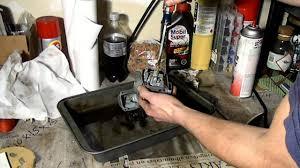
Difference Between Brake Cleaner & Carburetor Cleaner?
Q9powersportsusa.com StaffShare
Can I use both for the same thing, what's the difference?
When it comes to maintaining your vehicles, it is important to use the right products for the job. Two commonly used products in automotive maintenance are brake cleaner and carburetor cleaner. While both are designed to clean parts of your vehicle, there are important differences between them. In this article, we will explore the distinctions between brake cleaner and carburetor cleaner to help you understand their specific purposes and applications.
Brake Cleaner
Brake cleaner is a specialized cleaning solution used to clean brake components. It is specifically formulated to remove brake dust, oil, grease, and other contaminants from brake calipers, rotors, pads, and other braking system parts. Its main purpose is to ensure optimal brake performance and prevent brake squealing or sticking.
Brake cleaner typically contains chemicals like acetone, toluene, or methylene chloride, which are highly effective for removing brake dust and contaminants. These chemicals have strong solvency properties and evaporate quickly, leaving the brake components clean and residue-free. It is important to note that brake cleaner should not be used on other parts of the vehicle, as it can damage certain surfaces, such as paint or plastics.
When using brake cleaner, it is recommended to apply it directly to the brake components using a spray bottle or aerosol can. The spray nozzle allows for precise application and helps reach areas that are difficult to access. After applying the brake cleaner, it is important to wipe away any excess residue using a clean cloth or paper towel. For heavily soiled or stubborn areas, a brush can be used to agitate and remove the dirt.
Carburetor Cleaner
Carburetor cleaner, on the other hand, is designed to clean the carburetor of an internal combustion engine. The carburetor is responsible for mixing air and fuel in the right proportions for combustion. Over time, it can become clogged with dirt, varnish, and other deposits, leading to engine performance issues. Carburetor cleaner is specifically formulated to dissolve these deposits and restore the carburetor's proper function.
Unlike brake cleaner, carburetor cleaner usually contains a mixture of solvents like xylene or methanol. These solvents have the ability to break down and dissolve varnish, gum, and other deposits that accumulate in the carburetor. Carburetor cleaner also contains lubricants that help protect the carburetor's moving parts and prevent corrosion.
When using carburetor cleaner, it is important to follow the manufacturer's instructions. In most cases, the carburetor needs to be removed from the engine and soaked in the cleaner for a specific amount of time. This allows the cleaner to penetrate and dissolve the deposits effectively. After soaking, the carburetor should be rinsed thoroughly with clean water and dried before reinstallation.
Key Differences
While both brake cleaner and carburetor cleaner are solvents used for cleaning, they have some important differences:
- Chemical Composition: Brake cleaner typically contains chemicals like acetone, toluene, or methylene chloride, which are highly effective for removing brake dust and contaminants. On the other hand, carburetor cleaner usually contains a mixture of solvents like xylene or methanol, which are better suited for dissolving carburetor deposits.
- Usage: Brake cleaner is primarily used for cleaning brake components, such as calipers and rotors, to maintain their performance and prevent brake issues. Carburetor cleaner, on the other hand, is used specifically for cleaning the carburetor and improving engine performance.
- Application: Brake cleaner is typically applied directly to the brake components using a spray bottle or aerosol can. Carburetor cleaner is usually applied by removing the carburetor from the engine and soaking it in the cleaner or using a spray specifically designed for carburetor cleaning.
It is important to note that brake cleaner and carburetor cleaner are not interchangeable. Using brake cleaner on a carburetor can damage the delicate internal parts, while using carburetor cleaner on brake components may not effectively remove the brake dust and contaminants.
Conclusion
In summary, while brake cleaner and carburetor cleaner may seem similar at first glance, they serve different purposes in automotive maintenance. Brake cleaner is used to clean brake components and ensure optimal brake performance, while carburetor cleaner is used to dissolve deposits and restore the proper function of the carburetor. It is important to use the right cleaner for the specific job to achieve the best results and maintain your vehicle's performance.
Always refer to the manufacturer's instructions and safety precautions when using any cleaning products on your vehicle. If you are unsure about which cleaner to use or how to properly clean certain parts, it is recommended to consult with a professional mechanic or refer to your vehicle's maintenance manual.
By understanding the differences between brake cleaner and carburetor cleaner, you can make informed decisions when it comes to maintaining and cleaning your vehicle, ensuring its optimal performance and longevity.
